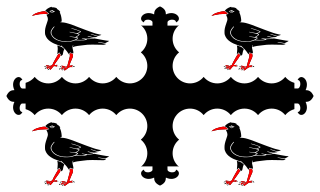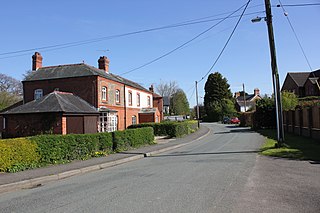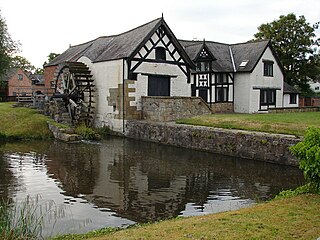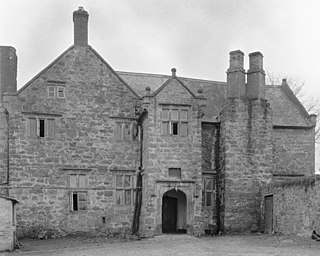
Rossett Hall is a mid-eighteenth century Grade II listed Georgian building situated in the village of Rossett, Wrexham County Borough, in the north of Wales. A former manor house, it is now a hotel under the Everbright Group. [1]

Rossett Hall is a mid-eighteenth century Grade II listed Georgian building situated in the village of Rossett, Wrexham County Borough, in the north of Wales. A former manor house, it is now a hotel under the Everbright Group. [1]
It was built in 1750 by John Boydell (1720–1804) as a country retreat for his family. Boydell was an engraver and publisher who became Lord Mayor of London in 1790.
Presently, Rossett Hall is operated by Everbright Group Hotels, it was a formerly independently owned hotel, with the hotel retaining much of the original manor house interior, such as the stone cantilevered staircase, grand chandelier, classical fireplace and lounge rooms. [2] [3]

Wrexham is a city and the administrative centre of Wrexham County Borough in Wales. It is located between the Welsh mountains and the lower Dee Valley, near the border with Cheshire in England. Historically in the county of Denbighshire, and later the county of Clwyd in 1974, it has been the principal settlement of Wrexham County Borough since 1996.

Flintshire, also known as the County of Flint, was one of the thirteen historic counties of Wales, in the north-east of Wales.

Wrexham County Borough is a county borough, with city status, in the north-east of Wales. It borders the English ceremonial counties of Cheshire and Shropshire to the east and south-east respectively along the England–Wales border, Powys to the south-west, Denbighshire to the west and Flintshire to the north-west. The city of Wrexham is the administrative centre. The county borough is part of the preserved county of Clwyd.

Wrexham is a parliamentary constituency centred on the city of Wrexham in the preserved county of Clwyd, Wales in the United Kingdom. It was created in 1918, and is represented in the House of Commons of the UK Parliament since 2024 by Andrew Ranger of the Labour Party.

St Giles' Parish Church is the parish church of Wrexham, Wales. The church is recognised as one of the finest examples of ecclesiastical architecture in Wales and is a Grade I listed building, described by Sir Simon Jenkins as 'the glory of the Marches' and by W. D. Caröe as a “glorious masterpiece.”

The Shrewsbury–Chester line is a railway line between Chester and Shrewsbury in England, with the line passing through Wrexham in Wales. Passenger train services are operated by Transport for Wales Rail between Chester, in the north, and Shrewsbury, in the south, as part of the Wales & Borders franchise. Some additional services, starting part way along the line to London Euston via Chester are operated by Avanti West Coast. The line was built in 1846 by the Shrewsbury and Chester Railway, with the engineer for the line being Henry Robertson, a partner in locomotive builders Beyer Peacock, while the contractor was Thomas Brassey in partnership with William Mackenzie and Robert Stephenson. The line is part of Transport for Wales' North Wales Metro improvement programme.

Marford is a village in Wrexham County Borough, Wales, near the Wales-England border.

Burton is a village in the community of Rossett in Wrexham County Borough, Wales. The hamlet of Burton Green is a separate settlement and is located around a mile northwest from Burton.

Rossett is a village, community and electoral ward in Wrexham County Borough, Wales. Rossett is served by the A483 road.

Wrexham is a constituency of the Senedd. It elects one Member of the Senedd by the first past the post method of election. Also, however, it is one of nine constituencies in the North Wales electoral region, which elects four additional members, in addition to nine constituency members, to produce a degree of proportional representation for the region as a whole.

Stansty is an area and electoral ward in Wrexham County Borough, Wales, lying to the immediate north-west of the city of Wrexham. It is a former civil parish and township. Stansty is also an electoral ward to Wrexham County Borough Council. The ward population as taken at the 2011 Census was 2,114.

Trevalyn Hall in Rossett, a Grade II* listed building, is an Elizabethan manor house near Wrexham in Wales. It was built by John Trevor in 1576. The Trevor family of Trevalyn were one of the leading families in East Denbighshire by about 1600 with numerous estates in both Flintshire and Denbighshire. The Plas Teg estate in Hope, Flintshire was also acquired by the Denbighshire branch of the family when it was purchased from a cousin by Sir John Trevor I (1563–1630) and it was he who built the present Plas Teg house in 1610.
Marchwiel Hall is a Grade II listed building in the village of Marchwiel, Wrexham County Borough in North Wales.

In the United Kingdom, the term listed building refers to a building or other structure officially designated as being of special architectural, historical, or cultural significance; Grade II* structures are those considered to be "particularly important buildings of more than special interest". Listing was begun by a provision in the Town and Country Planning Act 1947. Once listed, strict limitations are imposed on the modifications allowed to a building's structure or fittings. In Wales, the authority for listing under the Planning Act 1990 rests with Cadw.
The Rofft was a historic site at Marford in the Wrexham County Borough. It was initially a pre-historic camp, and later a motte and bailey castle. There are no visible remains of the site today.

Gallfaenan Hall, also known as Alltvaynan, is a Grade II listed building near to Trefnant and Henllan in Denbighshire, Wales.
Sydallt is a village in Gwersyllt community, Wrexham County Borough, north Wales. It had a population of 422 as of the 2011 UK census.

Fferm Farmhouse is a small Elizabethan manor house, located to the east of Pontblyddyn in the county of Flintshire, Wales. It is listed as a grade I historic building, as 'an exceptionally fine example of a small manorial house', particularly because it retains much of its original sub-medieval detail and layout. It was likely built during the late 16th century by John Lloyd, one of the Lloyds of nearby Hartsheath Hall, who is recorded as having inhabited the house in the period between 1575 and 1625. The exterior of the house follows the vernacular style of other such local buildings like Pentrehobyn Hall near Mold.
Wrexham North is a proposed railway station on the Shrewsbury–Chester line, situated between Rossett and Wrexham, in Wrexham County Borough, Wales. As of January 2022, there is no definitive site for the proposed station, with proposals including: the former Rossett railway station or a station near Pandy, Wrexham and Gresford. Unless construction of the station south of Rossett coincides with the full or partial dualling of the currently single track railway line towards Stansty, Wrexham North may be a single platform station or if situated at Rossett Junction be linked by a single track southwards to Wrexham.

In the United Kingdom, the term listed building refers to a building or other structure officially designated as being of special architectural, historical, or cultural significance; Grade II structures are those considered to be "buildings of special interest which justify every effort being made to preserve them". Listing was begun by a provision in the Town and Country Planning Act 1947. Once listed, strict limitations are imposed on the modifications allowed to a building's structure or fittings. In Wales, the authority for listing under the Planning Act 1990 rests with Cadw.
53°06′37″N2°56′42″W / 53.1102°N 2.9449°W